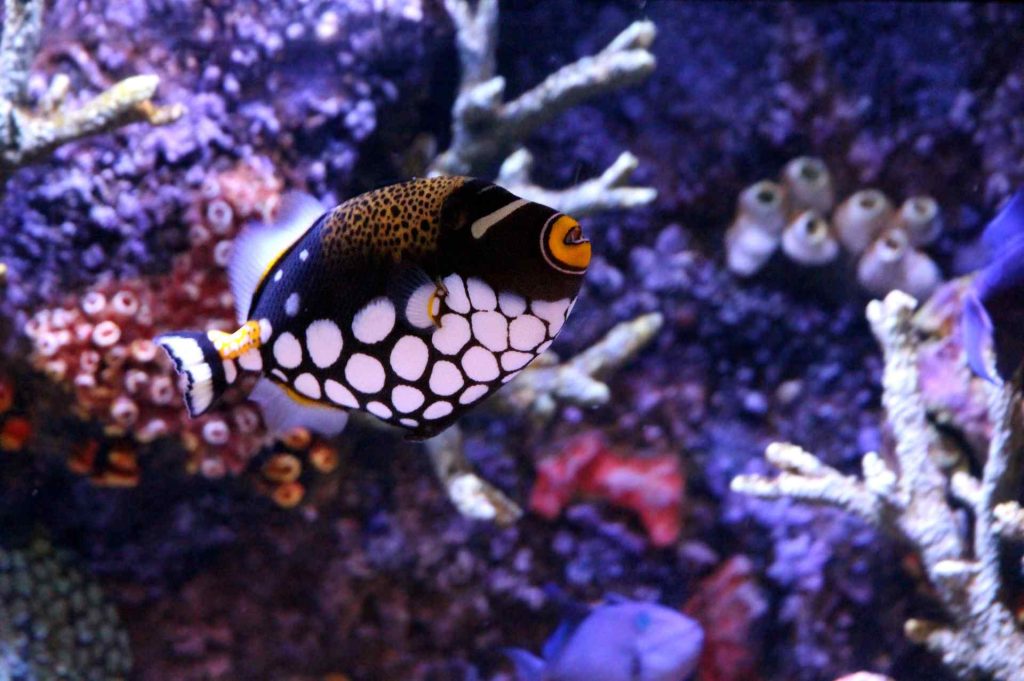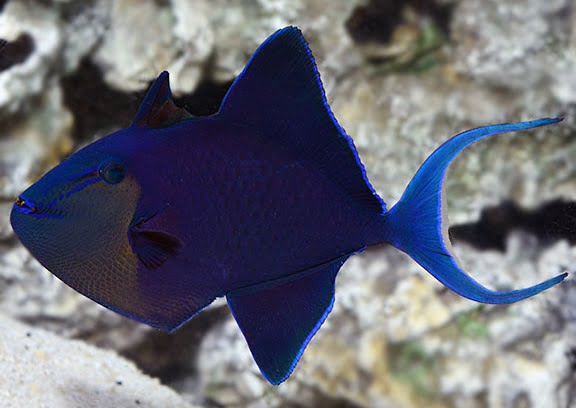The Triggerfish is a saltwater fish that seems popular because of its flashy appearance. I say “likely to be popular” rather than “popular” because this species is not very popular with experienced aquarists. The reason is that it is a little bit, it has strong teeth and can bite corals and live rocks, and in the worst case, it can bite the cord, and it isn’t easy to put in other fish with an amiable personality. However, there are still many aquarists, mainly beginners, who want to keep this fish. This time, I will introduce how to raise this Triggerfish.
- Standard name – Triggerfish
- Scientific name – Balistoides conspicillum (Bloch and Schneider, 1801)
Niger triggerfish?
The Redtooth Trigger or Niger Triggerfish is a striking fish for the aquarium at home. This kind of fish’s Niger Triggerfish can be any shade of purple, blue, or blue/green with a dramatic, lighter blue highlight on the fins and long tail lobes.
The color can also vary from day to day. Any fish in the home aquarium will have a different coloration depending on the color temperature of the lights. Niger triggerfish become dark purple in color with a blue/green glow around their faces as adults, and their brilliant red teeth make them quite attractive to see when they feed.
What kind of fish is the Triggerfish?
Triggerfish is a fish belonging to the family Triggerfish of the order Tetraodontiformes. Although it is named Kawahagi, it is a slightly different member from Kawasaki. It has three spines on its dorsal fin (2 spines on Kawahagi) and large scales on its body (small scales on Kawahagi). In terms of color, the large white spots on the abdomen, the yellow pattern on the back, and the yellow color around the mouth are colorful. It inhabits tropical and subtropical coral reefs in the Indo-Pacific region is more significant than most species of Stephanolepis crab and is said to have a total length of about 40 cm and a maximum of about 50 cm.

Unlike Kawahagi, Triggerfish is not often used as an edible product. This is because the internal organs may be poisoned or have ciguatera poison. Some species of the Triggerfish family, such as Triggerfish, Titan triggerfish, and Okihagi, are delicious to eat with sashimi and boiled. Still, it seems that the internal organs such as the liver are not edible.
The English name of the Triggerfish family is “Triggerfish”. This comes from the characteristics of the dorsal fin. When danger approaches, it escapes into rock holes and protects itself by raising the spines of its dorsal and pelvic fins to prevent them from being dragged out. This species is called Clown triggerfish. The clown is probably because of a strange pattern on the body side.
Triggerfish companion
Forty-three species of Triggerfish (including those of uncertain identification) are known from around the world. Of these, 24 species are distributed or reported in Japan. Like the Triggerfish, many of them have colorful and exciting patterns, and all of them are popular as ornamental fish. Still, many of them have a rough temper, so it can be said that they are not suitable for swimming with other fish.
Also, depending on the species, you can enjoy the color change of young and adult fish. Still, such species need to be handled with care because they become more prominent and have better teeth. In addition, to distinguish it from other species of Triggerfish, the common Japanese name of the species, which is called Triggerfish, may be distributed under the name of “Honmongara”.
Handling warning
Triggerfish have large teeth and strong jaws and can be injured if bitten. In addition, there are rows of spines near the tail stalk, so it is better to scoop up the water with a plastic case or bucket without grasping it with bare hands or a net as much as possible. Titan triggerfish, closely related to this species, is also considered dangerous if its teeth are firmly bitten.
Environment suitable for breeding Triggerfish
- Aquarium
We recommend the overflow tank, which is an acrylic tank. The author has stated that glass tanks are recommended and that known species can be bred without overflow tanks. Still, only the triggerfish family strongly recommends acrylic overflow tanks. .. There are several reasons for that.
- Become large
The Triggerfish is 40 cm in total length in nature, and even if it is bred, it will be close to 30 cm. Therefore, I want a large aquarium. I want to prepare a tank of at least 90 cm, preferably 120 cm. In addition, fish that grow to some extent like this has a large amount of excrement, and a solid filtration tank is also required. Therefore, the overflow tank is the best choice.
- There is a risk of biting the cord of the heater etc.
Triggerfish have strong teeth and jaws and are dangerous when bitten, but even more troublesome; they habit biting anything. Live rock and coral and heaters and cords may be gnawed depending on the individual and size. In that case, there is a danger of fire in the worst case. To prevent such a situation, it can be said that an overflow tank with a sump that can accommodate cords and heaters is ideal for breeding triggerfish.
- Sometimes it breaks the glass
The Triggerfish is not so much yet, but some species of this group will rush when they protect or surprise their eggs. Such types can break through the glass aquarium and should be used with caution.
- Water quality and filtration system
Triggerfish is a firm fish that can withstand any deterioration in water quality, but we want to keep it in as clean water as possible. However, the filtration system option is the overflow tank option for the above reasons. It is difficult to breed in a Berlin aquarium because it cannot be bred with coral, and excrement is large. To breed fish, it can be said that it should be bred by forced filtration with a biological filtration tank in the sump.
- water temperature
Triggerfish are fish that is abundant in the tropics, so keep it at around 25 ° C. The juveniles are said to be in a slightly more profound place, but they can still be bred at a water temperature of 25 ° C. The important thing is that the water temperature is constant, and if you do not keep the water temperature constant, you may get sick.
- Food suitable for breeding Triggerfish
Triggerfish are omnivorous, but they mainly eat crustaceans and sea urchins, and attached organisms and algae. It may also prey on small fish. If you give them crustaceans and sea urchins, they will be happy to prey on them. However, be careful not to pollute the water with too much food. It can be used as a compound feed and eats a lot of granular feed, but if possible, it is best to change the size of the grain of the feed as it grows.
